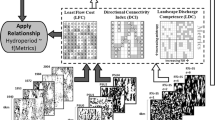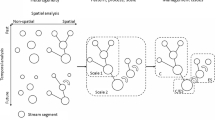Abstract
Investigations of European floodplain rivers demonstrate how landscape ecology can provide an effective framework to integrate pattern and process in river corridors, to examine environmental dynamics and interactive pathways between landscape elements, and to develop viable strategies for river conservation. The highly complex and dynamic nature of intact river corridors is particularly amenable to a landscape ecology perspective. Analysis of spatial patterns has provided considerable insight into environmental heterogeneity across river corridors and is an essential prelude to examining dynamic interactions. For example, data from aerial photographs, digitized maps and year-round field measurements in a glacial flood plain, enabled us to distinguish six channel types, based on the correspondence between connectivity and physicochemical attributes. Spatial data were also used to analyze longitudinal changes in landscape elements along the course of a morphologically-intact riverine corridor, providing insight into the structural complexity that must have characterized many Alpine rivers in the pristine state. Landscape indices were employed to investigate seasonal dynamics in a glacial flood plain of the Swiss Alps which exhibits a predictable expansion/contraction cycle, with corresponding shifts in flow paths (surface and subsurface) and water sources (snowmelt, englacial, subglacial, alluvial aquifer, hillslope aquifer). Surface connectivity exhibited an unexpected biphasic relationship with total channel length, whereas riverscape diversity progressively increased along the entire range of channel length. Reconstituting the functional integrity that characterizes intact river corridors should perhaps be the major goal of river conservation initiatives. Although understanding functional processes at the landscape scale is essential in this regard, few data are available. In the Alluvial Zone National Park on the Austrian Danube, three phases of hydrological connectivity were identified (disconnection, seepage connection and surface connection) that corresponded to the predominance of three functional processes (biotic interactions, primary production and particulate transport) within the river corridor.
Similar content being viewed by others
References
Amoros C. and Petts G.E. (eds) 1993. Hydrosystemes Fluviaux. Masson, Paris, France.
Arscott D.B., Tockner K. and Ward J.V. 2000. Aquatic habitat structure and diversity along the corridor of an Alpine floodplain river (The Fiume Tagliamento). Archiv für Hydrobiologie 149: 679-704.
Decamps H. 1984. Towards a landscape ecology of river valleys. In: J.H. Cooley and F.B. Golley (eds), Trends in Ecological Research for the 1980s, Plenum, New York, NY, USA, pp. 163-178.
Edwards P.J., Kollmann J., Gurnell A.M., Petts G.E., Tockner K. and Ward J.V. 1999. A conceptual model of vegetation dynamics on gravel bars of a large Alpine river. Wetlands Ecol. Manag. 7: 141-153.
Forman R.T.T. and Godron M. 1981. Patches and structural components for a landscape ecology. BioSci. 31: 733-740.
Gustafson E.J. 1998. Quantifying landscape spatial patterns: What is the state of the art? Ecosyst. 1: 143-156.
Gurnell A.M., Petts G.E., Hannah D.M., Smith B.P.G., Edwards P.J., Kollmann J., Ward J.V. and Tockner K. 2001. Riparian vegetation and island formation along the gravel-bed Fiume Tagliamento, Italy. Earth Surface Processes and Landforms 26: 31-62.
Johnson W.C. 1994. Woodland expansion in the Platte River, Nebraska, Patterns and causes. Ecol. Monogr. 64: 45-84.
Klein B. and Tockner K. 2000. Biodiversity in springbrooks of a glacial flood plain (Val Roseg, Switzerland). Verhandlungen der Internationalen Vereinigung für Theoretische und Angewandte Limnologie 27: 704-711.
Kollmann J., Vieli M., Edwards P.J., Tockner K. and Ward J.V. 1999. Interactions between vegetation development and island formation in the Alpine river Tagliamento. Appl. Veget. Sci. 2: 25-36.
Malard F., Tockner K. and Ward J.V. 1999. Shifting dominance of subcatchment water sources and flow paths in a glacial floodplain, Val Roseg, Switzerland. Arct. Antarct. Alp. Res. 31: 135-150.
Malard F., Tockner K. and Ward J.V. 2000. Physico-chemical heterogeneity in a glacial riverscape. Landsc. Ecol. 15: 679-695.
Osterkamp W.R. 1998. Processes of fluvial island formation, with examples from Plum Creek, Colorado and Snake River, Idaho. Wetlands 18: 530-545.
Petts G.E., Moller H. and Roux A.L. (eds) 1989. Historical changes of Large Alluvial Rivers, Western Europe, Wiley, Chichester, UK.
Schiemer F., Baumgartner C. and Tockner K. 1999. Restoration of floodplain rivers: 'The Danube Restoration Project'. Regul. Riv. Res. Manag. 15: 231-244.
Schumm S.A. 1985. Patterns of alluvial rivers. Ann. Rev. Earth Planet. Sci. 13: 5-27.
Stanford J.A., Ward J.V., Liss W.J., Frissell C.A., Williams R.N., Lichatowich J.A. and Coutant C.C. 1996. A general protocol for restoration of regulated rivers. Regul. Riv. Res. Manag. 12: 391-413.
Tockner K., Malard F., Burgherr P., Robinson C.T., Uehlinger U., Zah R. and Ward J.V. 1997. Physico-chemical characterization of channel types in a glacial floodplain ecosystem (Val Roseg, Switzerland). Archiv für Hydrobiologie 140: 433-463.
Tockner K., Schiemer F. and Ward J.V. 1998. Conservation by restoration: The management concept for a river-floodplain system on the Danube River, Austria. Aquat. Conserv. 8: 71-86.
Tockner K., Pennetzdorfer D., Reiner N., Schiemer F. and Ward J.V. 1999. Hydrological connectivity and the exchange of organic matter and nutrients in a dynamic river-floodplain system (Danube, Austria). Freshwater Biol. 41: 521-535.
Tockner K., Ward J.V., Arscott D.B., Edwards P.J., Kollmann J., Gurnell A.M., Petts G.E. andMaiolini B. The Tagliamento River: A model ecosystem for Alpine gravel-bed rivers. In: H. Plachter and M. Reich (eds), Ecology and Conservation of Gravel Bed Rivers and Alluvial Floodplains in the Alps. Springer, Berlin, Germany (in press).
Tockner K., Malard F. and Ward J.V. 2000. An extension of the flood pulse concept. Hydrol. Proc. 14, 2861-2883.
Turner M.G. and Gardner R.H. 1991. Quantitative methods in landscape ecology: An introduction. In: M.G. Turner and R.H. Gardner (eds), Quantitative methods in landscape ecology, Springer Verlag, New York, NY, USA, pp. 3-14.
Ward J.V. 1997. An expansive perspective of riverine landscapes: Pattern and process across scales. GAIA 6: 52-60.
Ward J.V. 1998. Riverine landscapes: Biodiversity patterns, disturbance regimes, and aquatic conservation. Biol. Conserv. 83: 269-278.
Ward J.V., Malard F., Tockner K. and Uehlinger U. 1999a. Influence of ground water on surface water conditions in a glacial flood plain of the Swiss Alps. Hydrol. Process. 13: 277-293.
Ward J.V., Tockner K., Edwards P.J., Kollmann J., Bretschko G., Gurnell A.M., Petts G.E. and Rossaro B. 1999b. A reference river system for the Alps: The Fiume Tagliamento. Regul. Riv. Res. Manag. 15: 63-75.
Ward J.V., Tockner K. and Schiemer F. 1999c. Biodiversity of floodplain river ecosystems: Ecotones and connectivity. Regul. Riv. Res. Manag. 15: 125-139.
Ward J.V., Tockner K., Edwards P.J., Kollmann J., Bretschko G., Gurnell A.M., Petts G.E. and Rossaro B. 2000. Potential role of island dynamics in river ecosystems. Verhandlungen der Internationalen Vereinigung für Theoretische und Angewandte Limnologie 27: 2582-2585.
Wiens J.A. 1995. Landscape mosaics and ecological theory. In: L. Hansson, L. Fahrig and G. Merriam (eds), Mosaic Landscapes and Ecological Processes, Chapman & Hall, London, UK, pp. 1-26.
Author information
Authors and Affiliations
Rights and permissions
About this article
Cite this article
Ward, J.V., Malard, F. & Tockner, K. Landscape ecology: a framework for integrating pattern and process in river corridors. Landscape Ecology 17 (Suppl 1), 35–45 (2002). https://doi.org/10.1023/A:1015277626224
Issue Date:
DOI: https://doi.org/10.1023/A:1015277626224




